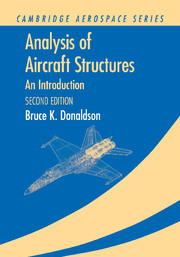Book contents
- Frontmatter
- Contents
- Introduction to the Second Edition
- Introduction to the First Edition
- List of Repeated Engineering Symbols
- Acknowledgments
- Part I The Fundamentals of Structural Analysis
- Part II **Introduction to the Theory of Elasticity**
- Part III Engineering Theory for Straight, Long Beams
- Part IV Work and Energy Principles
- Part V Energy-Based Numerical Solutions
- Part VI Thin Plate Theory and Structural Stability
- Appendix A Additional Topics
- Appendix B Selected Answers to Exercises
- References
- Index
Part V - Energy-Based Numerical Solutions
Published online by Cambridge University Press: 05 June 2012
- Frontmatter
- Contents
- Introduction to the Second Edition
- Introduction to the First Edition
- List of Repeated Engineering Symbols
- Acknowledgments
- Part I The Fundamentals of Structural Analysis
- Part II **Introduction to the Theory of Elasticity**
- Part III Engineering Theory for Straight, Long Beams
- Part IV Work and Energy Principles
- Part V Energy-Based Numerical Solutions
- Part VI Thin Plate Theory and Structural Stability
- Appendix A Additional Topics
- Appendix B Selected Answers to Exercises
- References
- Index
Summary
Preface
In Chapters 16–2, the focus shifts from solving differential equations to employing the Principle of Virtual Work, or the Principle of Complementary Virtual Work, or, for those who prefer them, the corresponding energy principles. The goal remains the same: to solve larger and more complicated structural analysis problems. The shift in focus is more stylistic than fundamental. As the last chapter's endnotes demonstrate, the beam differential equations follow from either the Principle of Virtual Work, in the case of bending and extension, or the Principle of Complementary Virtual Work, in the case of twisting. Although not demonstrated here, the reverse path from differential equations to a work or energy principle is also possible when the differential equation meets certain requirements as described by Ref. [3], p. 158. Hence it is essentially a matter of convenience whether a differential equation or a work principle is the starting point of an analysis. If the structure contains more than a couple of structural elements, it is usually, if not always, the work or energy principles that are most convenient. Indeed, one particular application of the Principle of Virtual Work – the finite element method – coupled with modern digital computers, permits the routine analysis of structures with many thousands of structural elements. The finite element method is a numerical method that is unperturbed by geometric or material complexity, and it allows the analyst to minutely model (and thus analyze) one part of a structure while getting by with a crude model of other parts of the structure.
- Type
- Chapter
- Information
- Analysis of Aircraft StructuresAn Introduction, pp. 521 - 522Publisher: Cambridge University PressPrint publication year: 2008



